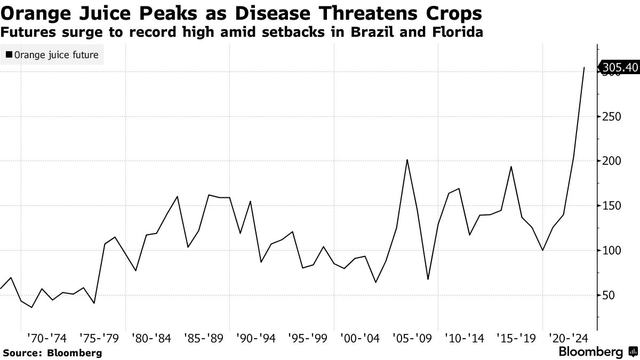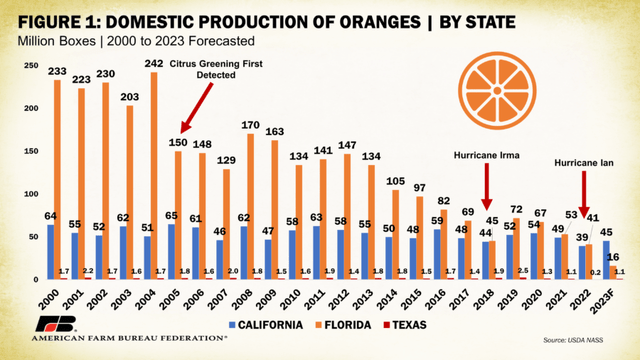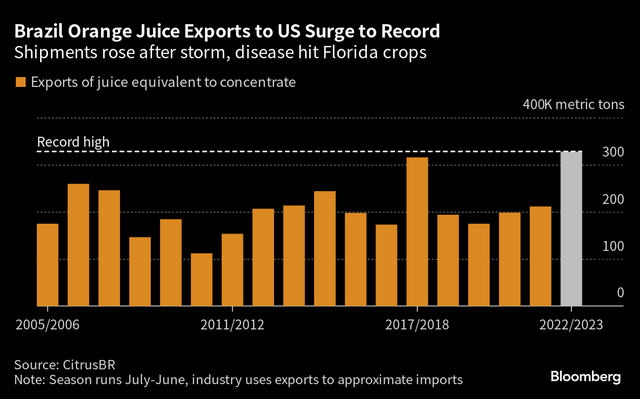Why Orange Juice Prices Are Trading At Record Highs In 2023
Maksim Safaniuk/iStock via Getty Images
The great thing about the financial markets is that there's always something moving. And as of early September, one of those things is orange juice futures.
Orange juice futures are currently trading at record highs, after a steady rally that started all the way back in early 2022.
At the start of last year, orange juice futures were trading for roughly $1.25/pound. Today, however, that same contract is trading for nearly triple that value-about $3.50/pound.
That's significant because prior to the start of this year, the previous all-time high in orange juice futures during the 21st century was about $2.20/pound.
Like all commodities markets, orange juice prices are driven by supply and demand dynamics in the marketplace. And since the middle of last year, dwindling supplies of orange juice have been driving prices higher.
Regionally, two of the most important producers of orange juice are Brazil and the United States, which constitute some 85% of the market. In the U.S., the states of California, Florida, and Texas produce the bulk of the country's oranges.
However, the oranges used to make juice are heavily concentrated (pun intended) in Florida. And that's because the climate in Florida is hotter and wetter as compared to California and Texas, which yields fruit generally sweeter and juicier.
Considering those market dynamics, one can see how prices might be extremely sensitive to any supply-side disruptions in Florida. And that's why the current crisis in Florida's orange growing areas has been such a key factor in the recent orange juice rally.
As a result of both disease and subpar growing conditions, orange harvests in Florida have been steadily declining in recent years. And according to CNN's Danielle Wiener-Bronner, the 2022-2023 growing season yielded about 50% less oranges than the 2021-2022 growing season, totaling about 16 million 90-pound boxes of oranges.
To put that number in context, 16 million boxes represents a 93% decline from Florida's peak output, and the weakest harvest since the end of World War II. In comparison, Florida pumped out upwards of 240 million boxes annually as recently as 1998.
The meager 2023 harvest has undoubtedly contributed to the current spike in prices, as highlighted below.

Bloomberg
Citrus Greening and Other Headwinds in the Florida Citrus Market
One of the primary drivers of lower yields in Florida has been the spread of a disease known as "citrus greening," which according to the U.S. Department of Agriculture (USDA) is the "most serious citrus plant disease in the world."
Citrus greening is also referred to as Huanglongbing (HLB), or yellow dragon disease, and spreads via an insect known as the Asian citrus psyllid.
Trees infected by HLB produce misshapen, bitter fruit which is considered unsuitable for sale as fresh fruit or juice. There is no known cure/treatment for HLB, and trees that are infected by the disease usually die within three years. It should be noted that citrus greening is not harmful to animals or humans.
According to research conducted by the University of Florida, citrus greening has devastated roughly 162,000 acres of citrus groves in Florida since 2007. And revenue lost to orange growers over that period is estimated at nearly $8 billion.
As if that wasn't enough, the Florida citrus industry has also lost trees due to extreme weather and floods associated with hurricanes (like Ian and Nicole). On top of that, the 2023/2024 orange harvest was also negatively impacted by a late freeze, which damaged budding trees.
Due to these significant headwinds, it's expected that 2023 will be the first year in history in which the California orange harvest is larger than Florida's, as illustrated below.

USDA
Growth in the California market has certainly helped offset shrinking supplies in Florida-especially when it comes to fresh, whole oranges sold in grocery stores.
However, as highlighted previously, oranges from the Californian market aren't well-suited for the orange juice segment. As a result, orange juice producers typically look to Brazil to fill any shortfalls left by Florida.
And in recent years, that shortfall has been growing ever larger. In 2018, roughly half the orange juice supply in the U.S. was attributable to oranges grown in Brazil. Today, it's undoubtedly higher, as evidenced by the recent surge in Brazilian orange juice exports to the U.S., highlighted below.

Bloomberg
Fortunately, Brazilian harvests have been relatively robust in recent years, which has helped alleviate the drop-off in production in Florida. During the 2022-2023 growing season, Brazil produced just over 300 million boxes of 90-pound boxes of oranges.
Of the 300 million boxes produced in Brazil, roughly 268 million were expected to be used for orange juice, because Brazil not only supplies the U.S. market, but also the European Union.
Importantly, however, Brazilian growers have also been facing some weather-related headwinds. As a result, the 2023/2024 growing season may not be as bountiful as the 2022/2023 growing season, which is likely why orange juice prices continue to rally.
Speaking to subpar growing conditions in Brazil, Bill Roberts-a senior analyst for the food and beverage sector at CoBank-recently commented, "Those Brazilian crop numbers coming in, I think, have caused a bit of concern around the industry."
Due to the ongoing supply complications in Brazil and Florida, most industry experts are forecasting that prices will remain elevated for the foreseeable future. However, if prices climb even higher, that could create demand destruction, whereby consumers start switching to other juice alternatives.
Analysts at Rabobank highlighted these new market realities in a recent research note, saying "For now, the base case is for elevated prices for longer, but demand destruction at high prices is a growing risk for volume sales this year."
This article is courtesy of Luckbox magazine.
Disclaimer: Investing carries risk. This is not financial advice. The above content should not be regarded as an offer, recommendation, or solicitation on acquiring or disposing of any financial products, any associated discussions, comments, or posts by author or other users should not be considered as such either. It is solely for general information purpose only, which does not consider your own investment objectives, financial situations or needs. TTM assumes no responsibility or warranty for the accuracy and completeness of the information, investors should do their own research and may seek professional advice before investing.

